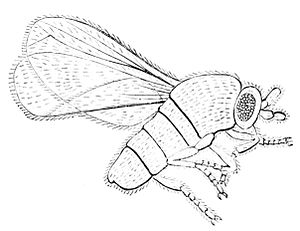Popular Science Monthly/Volume 15/September 1879/Development of the House-Fly
| DEVELOPMENT OF THE HOUSE-FLY. |
By M. H. ROBSON.
THE following remarks on the development of the house-fly are based on actual observation, and the appended sketches were made by Mr. G. Harkus from the microscope, with the aid of a Beales reflector.
Mr. Harkus, with whom I experimented simultaneously, was fortunate, or the reverse, in having the required ova brought to him in this way: A fly having gained access to a cold joint of lamb considerately left a sufficient supply for his examination. The objectionable part of the arrangement was probably counterbalanced by his being enabled to fix the time of deposition with tolerable certainty. This was on July 28th. The eggs (one of which is represented in Fig. 3, its diameter one thirtieth of an inch) were placed with a portion of the meat in a glass vessel, and next day the maggots had emerged as in Fig. 4 (diameter one twenty-fifth of an inch), where the ramifications of the tracheal system may be traced.
The warm weather, coupled with the indoor heat, matured the larva rapidly, the change from maggot to chrysalis (Fig. 2) being apparent at each observation, some having assumed this state on July

Fig. 1.—The House-Fly (Musca domestica), magnified.
30th. The perfect stage was reached and the fly emerged on August 5th, or eight days from the deposition of the ova (Fig. 1).
This was a week in advance of the result obtained in my experiment, which I preferred to conduct out of doors. A piece of raw liver was exposed, which soon had eggs enough attached to it. It would appear that the fly has to some extent the power of withholding the deposition of her ova until a suitable medium is found for the requirements of the larva.
In two or three days the maggots were at work; their activity and voracity in devouring the putrescent mass of animal matter gave it the appearance of fermentation.
For observation in the live box, any little weakness connected with the somewhat objectionable odor arising from the garbage had to be got rid of and some few maggots washed clean. Neither immersion in water nor yet compression seemed to inconvenience them appreciably;

| Fig. 2.—Chrysalis of House- Fly, July 20, 1878, x 40. |
Fig. 3.—Egg of House-Fly, July 28, 1878, x 30. |
their leathery integument is not easily ruptured, and is sufficiently translucent to render the trachea, as well as the undulatory vermicular movement of the internal organs, apparent throughout under a low power; in fact, from its toughness, transparency, and strength, the larva is an excellent object for microscopic examination. When the animal matter was devoured, the maggots moved restlessly about, changing in color from yellowish-white to brownish-red; the cuticle became dense and opaque; motion gradually ceased, until the perfect insect emerged by forcing of the segments of the anterior end of the shell, occupying from fourteen to fifteen days in completing its series of life-changes.
Mr. Harkus's part of the experiment appears to be useful so far as to show the adaptability of the fly and its ova to circumstances, and that the larva assumes the chrysalid state when its supply of food becomes exhausted, although otherwise immature (in this case the animal matter given them would dry up), instead of dying from starvation.
The chrysalis and fly in his examples are undersized and impoverished, compared to those permitted to feed in a semi-fluid mass of animal matter.
In autumn the house-fly seems specially the victim to the attacks of a parasitic fungus (Empusa muscæ), and may be seen glued, as it were, to walls, a white powdery growth appearing at the segments of its body (the spores of the fungus). This vegetable pest is similar to, if not identical with, the parasite which causes so much destruction among fish in aquariums, and last year even attacked salmon in some English rivers.
The cause of the fly becoming so firmly attached to dry surfaces is this: The two pulvilli which, with two strong curved claws (perhaps best seen with the flesh-fly, Musca vomitoria, as a subject), terminate

Fig. 4—Maggot of House-Fly, July 29, 1878, x 25.
the foot, are surrounded by a fringe of tubular hairs, each ending with a disk or sucker, through which a glutinous fluid exudes. These form the points of attachment, enabling the insect to walk in any position, the action of the two claws detaching these points as the fly moves along.
When the ravages of the parasite have sufficiently weakened the fly by the destruction of its viscera, etc., it becomes incapable of active movement, and, remaining too long in a place, the viscid fluid continues to exude, and then the fly "sticks to the wall."—Science Gossip.
